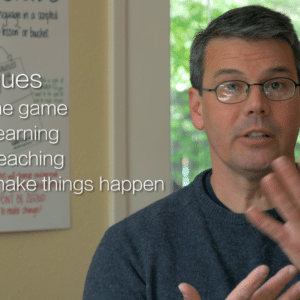When fluency hunting, you use limit to move through ascending levels of complex performance, leaving a Travels with Charlie roadmap behind you, and calling sorry, charlie on yourself or others anytime bite-sized pieces come up out of order.
One quick look at the Big Picture can make all the details fall into place.
We call Travels with Charlie a roadmap, because it can be very similar. When you drive somewhere new, it always feels faster on the way back, than the way out. This is because you know what to expect. You also have learned short-cuts and other ways to save time and resources (the best gas station, a good grocery store, etc.).
The good folks at ACTFL, the American Council on the Teaching of Foreign Languages, have done this work for all us language learners by developing several decades ago a language proficiency scale outlining the big picture of language acquisition. They run workshops and classes on using the scale.
The scale runs:
Novice: Memorized words and phrases, listing.
Intermediate: Full sentence questions and answers.
Advanced: Paragraphs about a specific moment in time, in the past, present and future.
Superior: Speeches and discussions about economic, social, and political issues.
For WAYK, we needed something memorable and succinct, so we developed this “iconic” version:
Novice: Tarzan at a party. Me Tarzan. Like food! “Sesame Street”
Intermediate: Getting to the party. “Mr. Roger’s Neighborhood”
Advanced: What happened at the party last night? “Larry King Live”
Superior: What if parties were illegal? “Charlie Rose”
We love this scale so much, we use it as an over-arching concept for every skill we want to hunt, including the craft of language hunting itself. This scale is essentially an appreciative (it’s about what you can do, not what you can’t), organic scale for ever-increasing complex performance. If you think of a seed moving from a seedling to a full grown plant, at each level important activity is happening, it’s just not as complex as the next. A seed isn’t worse than a tree; without the seed there is no tree! The seed is actually the ingenious starting point for making a tree, and is quite an accomplishment in itself. This is exactly how we think of WAYK.
This is a vital paradigm shift, and can really require screwing on your head in a completely different way. In this way of seeing “learning”, there are no remedial classes, there are no classes for the talented and gifted, there is only organic growth up the scale, to higher and higher levels of performance.
Here’s the scale for WAYK language hunting:
Novice: Plays the game.
Intermediate: Leads games and hunts languages.
Advanced: Hosts language nights, and leads teams of language hunters.
Superior: Hosts language weekends, and leads communities of language hunters.
There’s a very natural progression there. Though it may seem obvious, it can often take a lot of work to suss out the scale for new skills. What is Novice for bicycle mechanics? Boxing? Web development? Algebra? Piano? How about Intermediate, Advanced, and Superior?
Though a separate technique, you can’t talk about travels with charlie without sorry, Charlie. This is the technique you call when someone is trying to add bite-sized pieces out of order, or even try to jump a level of proficiency in play (for example, jumping to telling stories, rather than staying with full sentence Q&A). This someone may in fact be you! You’ll know this is happening when the game grinds to a halt, you fall out of the flow of play, and players start “explaining” the language, rather than conversing in it.
It’s common for players to rename travels with charlie to be more appropriate for their home culture. Not everyone has heard of the PBS interviewer “Charlie Rose”, after which this technique was named (the other being the book Travels with Charlie by John Steinbeck)! This is a great idea, especially if you do it well. You can also come up with your own iconic TV shows or people for each level of proficiency on the scale.
Introducing the technique in language acquisition
There is no short version of this technique, really. We tend to introduce it later on, after play has been going for a while, as an opportunity for a short break and a look at the “big picture”. A quick run through of the scale, as shown above, takes about 5-10 minutes, depending on how succinct you are.
Applying the technique in language acquisition
When you mark this technique, it’s like a tiny little game unto itself. Throw my turn/your turn and in threes to make sure players can explain it to you and others.
But what about…?
You will use the heck out of sorry, charlie. It is a work-horse, and one of the main techniques that will keep old language class habits from slowing the game down. Use it early and often! Players get excited and want to increase complexity all the time, before they really understand how the ACTFL scale works. It’s up to you to throw this technique again, and again, combining it with others if necessary (How Fascinating!, in threes, my turn/your turn, etc.).





